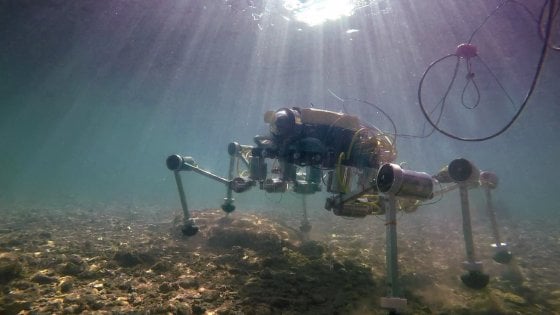Silver 2 is a “crab robot” that removes plastic from the sea: it was born from the partnership between the Scuola Superiore Sant’Anna in Pisa and the Anton Dohrn Station in Naples.
How to save the sea from plastic? The question has been echoing with insistence for some years now and the solutions suggested are many. One of the most recent (and extravagant) comes from Italy. Experts from the BioRobotics Laboratory of the Scuola Superiore Sant’Anna in Pisa and biologists from the Anton Dohrn Zoological Station in Naples have joined forces and designed an underwater robot capable of collecting and removing plastic from the sea bed. The robot is called Silver 2 and is in all respects similar to a crab. The creators of the project were inspired by this sea creature to develop a robot capable of moving on rough and uneven terrain without altering the seabed or damaging the marine ecosystem. Just like a crab, Silver 2 is equipped with six articulated and sprung legs that allow it to jump (even laterally) between rocks and collect sand, plastic or any other material that has settled on the seabed. The project was presented in a study published in the authoritative international journal Science Robotics.
You might also be interested in —> Scribit: the Italian robot that “brings” art on the walls of the house
Silver 2: A robotic crab to save the sea from the plastic
The “crab-robot” was developed by an international team coordinated by Giacomo Picardi – PhD student of Phd in BioRobotics – doctor Marcello Calisti – researcher at the Scuola Superiore Sant’Anna in Pisa – and doctor Cecilia Laschi, expert in soft-robotics (a subfield of robotics that deals with the construction of robots with movement mechanisms similar to those of living organisms). “SILVER 2 – comments Giacomo Picardi – is currently remotely controlled by an operator through a graphical interface that allows you to see what the robot sees and decide the direction and type of locomotion. Through the interface it is also possible to visualize the characteristics of the underwater environment, such as pressure or temperature detected by the on-board sensors”. Marcello Calisti spoke about the possible applications of the robot crab. “When you think about the exploration of the sea, submarines or similar vehicles come to mind, swimming until they reach the objects of interest, typically on the seabed. We thought of overturning the concept: to go directly to the bottom, with a robot with legs, to interact in a more delicate and effective way. The difficulties of perceiving the marine environment prevent the use of traditional algorithms that are used for land-based robots: but with our bio-inspired approach, we managed to combine both the effectiveness and the delicacy of locomotion. Our ambition is to collaborate with the technologies that exist today to create a whole ecosystem of underwater robots that can care for, explore and maintain the marine environment and related activities. In this, we have been very happy to work with biologists, geologists and oceanographers who have always seen our unconventional approach with interest.
You might be also interested in —> The new robotic arm is inspired by octopuses
